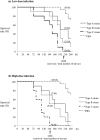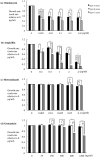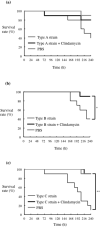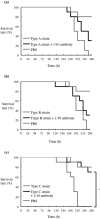Efficacy of FimA antibody and clindamycin in silkworm larvae stimulated with Porphyromonas gulae
- PMID: 33968314
- PMCID: PMC8079003
- DOI: 10.1080/20002297.2021.1914499
Efficacy of FimA antibody and clindamycin in silkworm larvae stimulated with Porphyromonas gulae
Abstract
Objective: Porphyromonas gulae, a major periodontal pathogen in animals, possesses fimbriae that have been classified into three genotypes (A, B, C) based on the diversity of fimA genes encoding fimbrillin protein (FimA). P. gulae strains with type C fimbriae were previously shown to be more virulent than other types. In this study, we further examined the host toxicity mediated by P. gulae fimbriae by constructing recombinant FimA (rFimA) expression vectors for each genotype and raised antibodies to the purified proteins. Methods and Results: All larvae died within 204 h following infection with P. gulae type C at the low-dose infection, whereas type A and B did not. Among fimA types, the survival rates of the larvae injected with rFimA type C were remarkably decreased, while the survival rates of the larvae injected with rFimA type A and type B were greater than 50%. Clindamycin treatment inhibited the growth of type C strains in a dose-dependent manner, resulting in an increased rate of silkworm survival. Finally, type C rFimA-specific antiserum prolonged the survival of silkworm larvae stimulated by infection with P. gulae type C strain or injection of rFimA type C protein. Conclusion: These results suggested that type C fimbriae have high potential for enhancement of bacterial pathogenesis, and that both clindamycin and anti-type C rFimA-specific antibodies are potent inhibitors of type C fimbriae-induced toxicity. This is the first report to establish a silkworm infection model using P. gulae for toxicity assessment.
Keywords: Fimbriae; Porphyromonas gulae; genotypes; silkworm larvae.
© 2021 The Author(s). Published by Informa UK Limited, trading as Taylor & Francis Group.
Conflict of interest statement
No potential conflict of interest was reported by the author(s).
Figures









Similar articles
-
Diversity of fimbrillin among Porphyromonas gulae clinical isolates from Japanese dogs.J Vet Med Sci. 2012 Jul;74(7):885-91. doi: 10.1292/jvms.11-0564. Epub 2012 Mar 2. J Vet Med Sci. 2012. PMID: 22382732
-
Inhibition of Porphyromonas gulae and periodontal disease in dogs by a combination of clindamycin and interferon alpha.Sci Rep. 2020 Feb 20;10(1):3113. doi: 10.1038/s41598-020-59730-9. Sci Rep. 2020. PMID: 32080231 Free PMC article.
-
Functional differences among FimA variants of Porphyromonas gingivalis and their effects on adhesion to and invasion of human epithelial cells.Infect Immun. 2002 Jan;70(1):277-85. doi: 10.1128/IAI.70.1.277-285.2002. Infect Immun. 2002. PMID: 11748193 Free PMC article.
-
Molecular interaction of Porphyromonas gingivalis with host cells: implication for the microbial pathogenesis of periodontal disease.J Periodontol. 2003 Jan;74(1):90-6. doi: 10.1902/jop.2003.74.1.90. J Periodontol. 2003. PMID: 12593602 Review.
-
[FimA fimbriae of the periodontal disease-associated bacterium Porphyromonas gingivalis].Yakugaku Zasshi. 2013;133(9):963-74. doi: 10.1248/yakushi.13-00177. Yakugaku Zasshi. 2013. PMID: 23995804 Review. Japanese.
Cited by
-
Porphyromonas gulae and canine periodontal disease: Current understanding and future directions.Virulence. 2025 Dec;16(1):2449019. doi: 10.1080/21505594.2024.2449019. Epub 2025 Jan 21. Virulence. 2025. PMID: 39834343 Free PMC article. Review.
-
Glycan-Adhering Lectins and Experimental Evaluation of a Lectin FimH Inhibitor in Enterohemorrhagic Escherichia coli (EHEC) O157:H7 Strain EDL933.Int J Mol Sci. 2022 Sep 1;23(17):9931. doi: 10.3390/ijms23179931. Int J Mol Sci. 2022. PMID: 36077327 Free PMC article.
References
-
- Kato Y, Shirai M, Murakami M, et al. Molecular detection of human periodontal pathogens in oral swab specimens from dogs in Japan. J Vet Dent. 2011;28(2):84–13. - PubMed
-
- Hamada N, Takahashi Y, Watanabe K, et al. Molecular and antigenic similarities of the fimbrial major components between Porphyromonas gulae and P. gingivalis. Vet Microbiol. 2008;128(1–2):108–117. - PubMed
-
- Yamasaki Y, Nomura R, Nakano K, et al. Distribution and molecular characterization of Porphyromonas gulae carrying a new fimA genotype. Vet Microbiol. 2012a;161(1–2):196–205. - PubMed
-
- Iwashita N, Nomura R, Shirai M, et al. Identification and molecular characterization of Porphyromonas gulae fimA types among cat isolates. Vet Microbiol. 2019;229:100–109. - PubMed
LinkOut - more resources
Full Text Sources
Molecular Biology Databases
